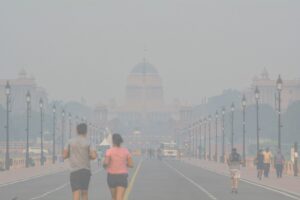 With Delhi air quality once again under global scrutiny, Chief Minister Rekha Gupta on Tuesday rolled out the Air Pollution Mitigation Plan 2025 a bold, tech-powered initiative to combat the capital’s perennial pollution crisis.
With Delhi air quality once again under global scrutiny, Chief Minister Rekha Gupta on Tuesday rolled out the Air Pollution Mitigation Plan 2025 a bold, tech-powered initiative to combat the capital’s perennial pollution crisis.
Under the sweeping measures:
▸ Anti-smog guns are now mandatory for all high-rise commercial structures in Delhi malls, hotels, and office complexes exceeding 3,000 sq metres.
▸ Mist sprayers will be deployed at 13 identified air pollution hotspots across the city.
▸ From 1 November, only BS-VI compliant, electric, and CNG vehicles will be allowed to enter Delhi’s borders.
Gupta’s announcement marks one of the most stringent efforts to date in tackling the city’s toxic air, especially as Delhi braces for yet another hazardous winter season.
AI Cameras to Target Polluting Vehicles
The government will install Automatic Number Plate Recognition (ANPR) cameras at all entry points and petrol stations in Delhi. These smart systems will detect “end-of-life” vehicles those beyond permissible emission age and alert authorities for immediate action.
“Pollution caused by outdated vehicles cannot be ignored any longer. We will use technology to identify and eliminate them from the roads,” said CM Gupta.
Delhi Eyes Artificial Rain
In a landmark move, the Delhi government signed an MoU with IIT Kanpur for a pilot cloud seeding project aimed at inducing artificial rain to wash away pollutants. This will be Delhi’s first attempt at using weather modification to clear the air.
Gupta called it “a scientific leap” and a symbol of Delhi’s openness to innovation in climate resilience.
According to a recent Centre for Science and Environment (CSE) report, Delhi witnessed only 121 days of air meeting national quality standards in 2024 a steep drop from 152 days in 2023. The AQI breached 400 in at least 14 localities last November.
With smog seasons getting longer and deadlier, the urgency is clear.
The Broader Plan: Community + Tech
The plan combines real-time monitoring, stricter entry norms, and public-private coordination. CM Gupta emphasized the city’s focus on both “immediate mitigation and long-term transformation.”
Last week, the Commission for Air Quality Management (CAQM) had briefly activated Stage-I of the Graded Response Action Plan (GRAP) due to a pollution spike, which was lifted once conditions improved.
While enforcement remains a concern, Delhi’s 2025 roadmap signals a firm shift towards proactive governance and science-backed interventions.
If successful the capital ambitious plan may well set a precedent for other smog-choked cities across South Asia.
